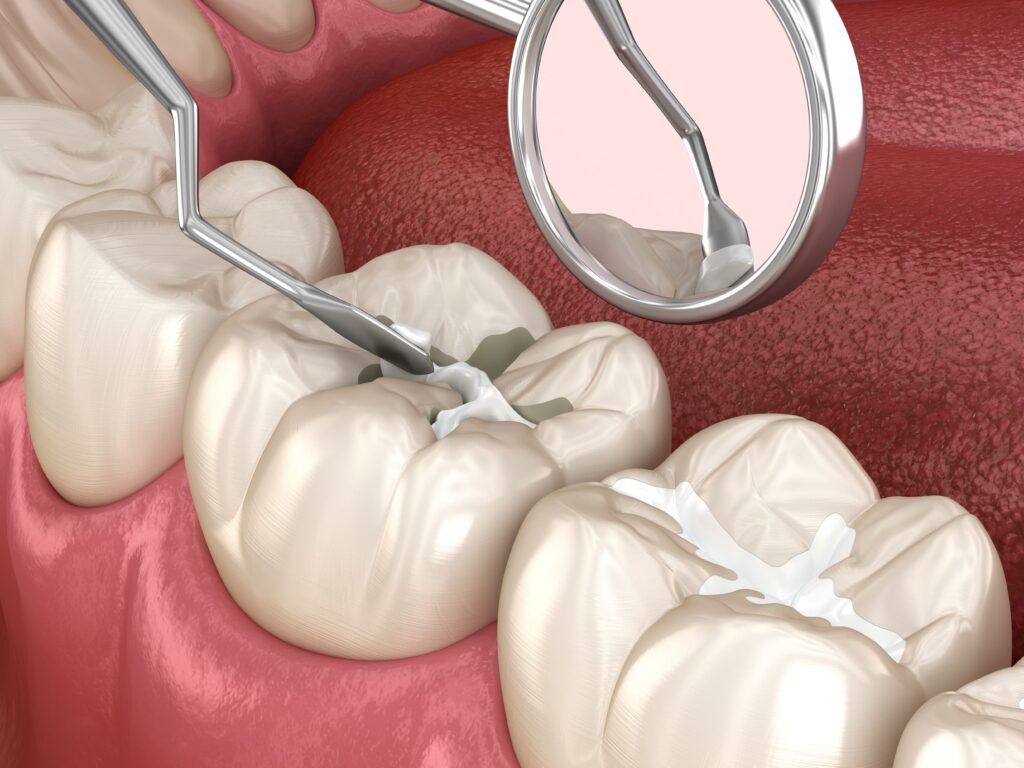When it comes to dental restorations, patients often find themselves at a crossroads, deciding between dental fillings and dental crowns. Both options serve to restore the integrity and function of a tooth, but they are used in different scenarios and offer distinct advantages. In this blog, we’ll delve into the differences between the two and provide guidance on how to choose the right type of restoration for your needs.
Dental Fillings: The Basics
Dental fillings are materials used to fill cavities or small holes in the teeth caused by decay. They literally “fill” the void, preventing further decay and restoring the tooth’s function. Fillings are ideal for small to moderate cavities where there’s enough healthy tooth structure remaining.

Fillings can be made from a variety of materials, including:
- Amalgam (silver-colored)
- Composite resin (tooth-colored)
- Gold
- Porcelain
Dental fillings are a routine yet essential procedure in dentistry, primarily used to restore teeth compromised by decay or minor damage. The process begins with the dentist ensuring the patient’s utmost comfort, typically by administering a local anesthetic to numb the affected area. Once numbness is achieved, specialized tools, such as dental drills or lasers, are employed to meticulously remove the decayed sections of the tooth. This step is pivotal, as thorough removal of decay prevents its further spread.
Following the removal, the cavity is cleaned rigorously to eliminate any lingering bacteria or debris, setting the stage for the filling. Depending on the patient’s preference and the dentist’s recommendation, various filling materials like amalgam, composite resin, gold, or porcelain can be chosen. If using a composite resin, a specialized light is used to harden each layer of the filling material.
After the cavity is completely filled, the dentist shapes the material to mimic the tooth’s natural structure, ensuring a comfortable bite for the patient. The procedure concludes with the polishing of the filling, smoothing any roughness and enhancing its appearance to seamlessly blend with the natural tooth. With modern dental advancements, fillings are not only long-lasting but also aesthetically harmonious with the surrounding teeth.
Advantages of Dental Fillings:
- Less invasive procedure
- Preserves more of the natural tooth
- Cost-effective
- Quick treatment time
Dental Crowns: The Basics
Dental crowns, often referred to as “caps,” are restorations that cover the entire visible part of a tooth. They are used when a tooth is significantly damaged or weakened. Crowns are recommended for teeth that are severely decayed, have been weakened by large fillings, have been treated with a root canal, or that are broken or fractured.

Crowns can be crafted from:
- Porcelain (often fused to metal)
- Ceramic
- Gold or other alloys
- Resin
Dental crowns, often referred to as “caps,” are custom-made restorations designed to cover and protect a damaged or weakened tooth. The process of placing a dental crown typically begins with the dentist preparing the affected tooth by removing any decay and reshaping it to accommodate the crown. This might involve reducing the tooth’s size or building it up if it’s severely worn down.
Once the tooth is prepared, an impression or digital scan is taken to create a precise mold for the crown. This mold is then sent to a dental laboratory where the crown is fabricated, usually from materials like porcelain, ceramic, gold, or other alloys. While waiting for the permanent crown, a temporary one is often placed to protect the prepared tooth. Once the custom-made crown is ready, the dentist will ensure it fits perfectly, make any necessary adjustments, and then cement it in place. The result is a fully restored tooth that functions and often looks just like a natural one.
Advantages of Dental Crowns:
- Provides strength to a weakened or broken tooth
- Can improve the appearance of misshapen or discolored teeth
- Long-lasting with proper care
- Protects the tooth from further damage
Making the Right Choice: Fillings or Crowns?
When deciding between a dental filling and a dental crown, several factors come into play. Making the right choice is crucial for the longevity, functionality, and aesthetics of the restored tooth. Here are the key factors one should consider:
Extent of Damage:
- Minor to Moderate Decay: If the tooth has a small cavity or minor decay, a filling might suffice.
- Severe Decay or Damage: If a significant portion of the tooth is affected, or if there’s a large fracture, a crown may be necessary to provide adequate strength and protection.
Tooth Location and Function:
- Front Teeth: For aesthetic reasons, a tooth-colored filling or crown might be preferred for visible teeth.
- Back Teeth (Molars): These teeth bear the brunt of chewing forces. If they’re significantly compromised, a crown might offer better durability.
Previous Restorations:
If a tooth already has a large filling, it might be more susceptible to breakage. In such cases, a crown can offer added protection.
Aesthetic Concerns:
Fillings, especially composite ones, can be closely matched to the color of natural teeth. However, for teeth that are severely discolored or misshapen, crowns can provide a more comprehensive cosmetic solution.
Longevity and Durability:
While fillings can last many years, crowns generally offer a longer lifespan, especially when dealing with extensive damage.
Root Canal Treatment:
Teeth that have undergone root canal treatment can become brittle over time. A crown can help protect such teeth from fractures.
Cost and Insurance Coverage:
Dental fillings are typically less expensive than crowns. It’s essential to consider your budget, insurance coverage, and the potential long-term costs of future treatments.
Treatment Time:
Fillings can usually be completed in a single appointment, while crowns often require at least two visits.
Material Allergies or Sensitivities:
Some people might be allergic or sensitive to certain materials used in fillings or crowns, such as metal. It’s essential to discuss any known allergies with your dentist.
Overall Oral Health:
If there’s gum disease or other oral health issues, these might influence the decision. For instance, it might be necessary to address gum disease before placing a crown.
Dentist’s Recommendation:
Your dentist will provide expert advice based on a thorough examination of the tooth, your oral health, and your personal preferences.
Overall, while both dental fillings and crowns serve to restore teeth, the decision between them hinges on the specific circumstances and needs of the patient. Always consult with your dentist to make an informed choice that best suits your oral health and aesthetic desires.
In Conclusion
Both dental fillings and crowns play a crucial role in maintaining oral health and function. While fillings are best suited for minor restorations, crowns offer comprehensive coverage and protection for severely compromised teeth. By understanding the differences and consulting with your dentist, you can make an informed decision that ensures the longevity and beauty of your smile.

Dr. Sadati possesses extensive experience in all aspects of advanced restorative dentistry, with an emphasis in cosmetic and implant dentistry. He has attained Accredited Fellow status in the American Academy of Cosmetic Dentistry (AACD), the most rigorous, demanding credentialing process in the world. He is the only AACD Accredited Fellow in South Florida.


